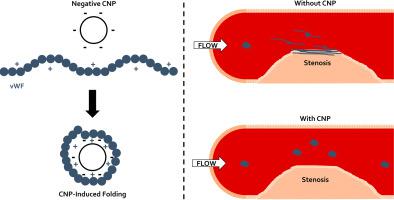Nanomedicine: Nanotechnology, Biology and Medicine ( IF 4.2 ) Pub Date : 2021-04-28 , DOI: 10.1016/j.nano.2021.102405 Michael T Griffin 1 , Katrina Ashworth 2 , Nathaniel Hill 1 , Jaydra von Behren 1 , Jorge Di Paola 3 , David N Ku 1

|
Platelet accumulation by VWF under high shear rates at the site of atherosclerotic plaque rupture leads to myocardial infarction and stroke. Current anti-platelet therapies remain ineffective for a large percentage of the population, while presenting significant risks for bleeding. We explore a novel way to inhibit arterial thrombus formation. Theoretically, a negative charge may influence the tertiary structure of VWF to favor the globular configuration by biophysical means without the use of platelet inactivating drugs. We tested this hypothesis experimentally for charged nanoparticles (CNPs) to inhibit thrombus formation in a microfluidic thrombosis assay (MTA). Several different CNPs demonstrated the ability to retard thrombotic occlusion in the MTA. A preliminary study in mice shows that thrombus stability is weaker with CNP administration and bleeding times are not markedly prolonged. The CNPs tested here show promise as a new class of antithrombotic therapies that act by biophysical means rather than biochemical pathways.
中文翻译:

多种材料的负电荷纳米粒子抑制剪切诱导的血小板积累
VWF 在动脉粥样硬化斑块破裂部位的高剪切率下积聚血小板导致心肌梗塞和中风。目前的抗血小板疗法对大部分人群仍然无效,同时存在显着的出血风险。我们探索了一种抑制动脉血栓形成的新方法。从理论上讲,负电荷可能会影响 VWF 的三级结构,以通过生物物理手段支持球状结构,而无需使用血小板灭活药物。我们用带电纳米粒子 (CNPs) 对这一假设进行了实验验证,以在微流体血栓形成测定 (MTA) 中抑制血栓形成。几种不同的 CNP 证明了延缓 MTA 中血栓形成的能力。对小鼠的初步研究表明,CNP 给药后血栓稳定性较弱,出血时间没有明显延长。这里测试的 CNP 显示出作为一类新的抗血栓疗法的前景,它通过生物物理手段而不是生化途径起作用。











































 京公网安备 11010802027423号
京公网安备 11010802027423号